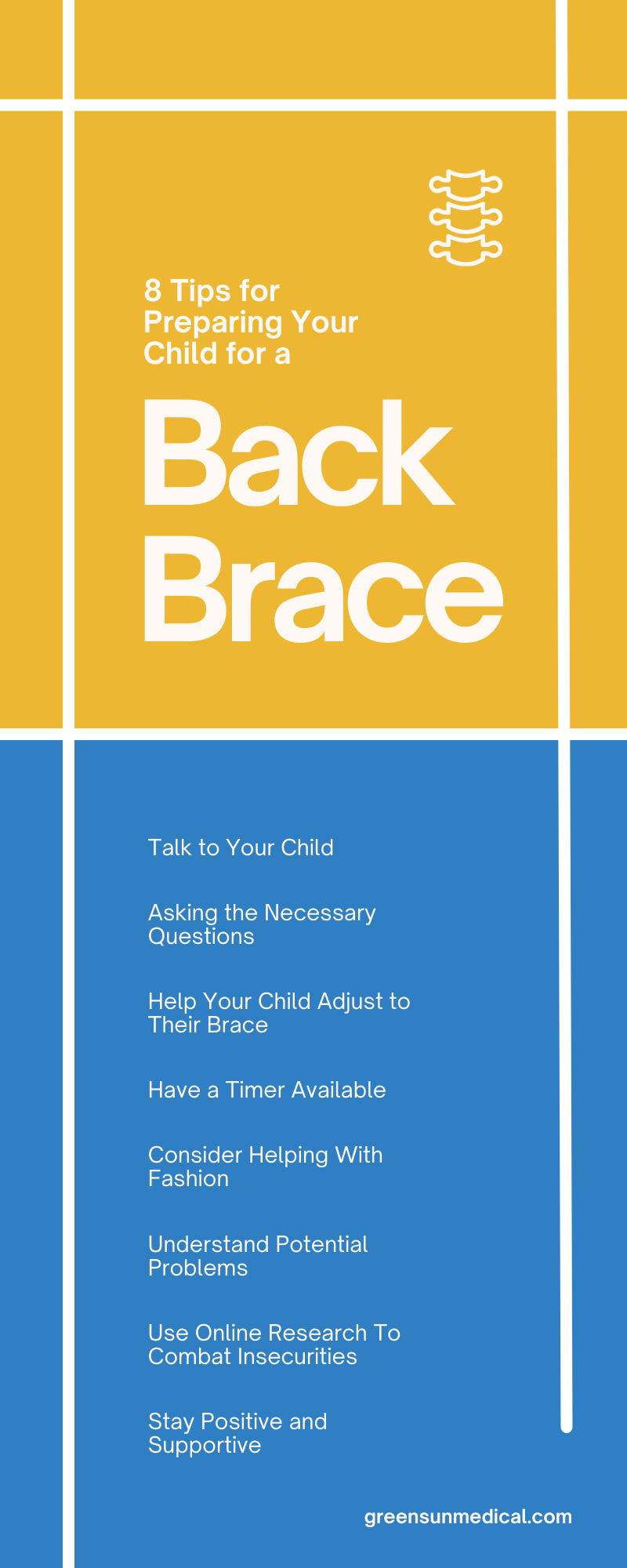Scoliosis affects your child not only physically but also emotionally. Depending on how old they are, they become more aware of their peers and social expectations. So, they might feel worried about being teased or how the back brace will make them look as they attend classes or social activities.
The best approach to helping your child worry less is becoming better informed about back braces and how to help your child make a habit of wearing theirs. Doing so will help them feel less worried and slowly learn to embrace it. So here are eight tips for preparing your child for a back brace.
Talk to Your Child
If your child has been diagnosed with scoliosis, they might have some fears about wearing a back brace. Your child might have worries about their peers’ opinions and thoughts on their brace. The best thing you can do to help your child overcome these worries is to allow them to talk through their feelings. So, one of the tips for preparing your child for a back brace is to let them talk through their emotions.
Providing your child with a listening ear will allow them to feel better about and become more open to wearing a brace. Additionally, it’s important to remind them that they won’t wear one for the rest of their life. Back braces help to improve and benefit them physically, but they aren’t permanent.
Asking the Necessary Questions
When you’re at the orthopedic provider with your child, it’s important to ask the right questions about the back brace. Start by asking about comfort, taking the brace on and off throughout the day, the wear period, and so on. As the orthopedic professional answers your own questions, it will give your child time to think over any questions they may have.
Asking any questions you and your child have about the brace will help you both understand the importance of wearing it. If either of you has additional questions after the appointment, contact your medical professional about those lingering thoughts.
Help Your Child Adjust to Their Brace
Incorporating a back brace into a child’s routine can feel challenging at first. But if you stay consistent and careful, your child will adjust to their brace in no time. You can help them by going over the basics of the back brace and how it works with your orthopedic provider.
At the appointment, the orthopedic specialist will examine your child and recommend a brace for their type of scoliosis, the severity of the curve, and its location in the spine. The orthotist will gradually adjust or replace the brace to prevent your child’s scoliosis from worsening as they grow. Make sure you keep a consistent routine with your child, intentionally talking with them about their progress and overall feelings at least once a week.
Have a Timer Available
Talking to your orthotist will help you understand setting a schedule for your child’s back brace. Set aside time to figure out what kind of schedule will work for both you and your child so you can monitor their comfort and they can get used to the brace. Before having your child wear the brace for the full, prescribed time, take a week to prepare them for long-term wear with this schedule or a similar one:
- Day 1: Wear the brace for two hours.
- Day 2: Wear the brace for four hours, broken into short periods if needed.
- Day 3: Wear the brace for six hours.
- Day 4: Wear the brace for eight hours.
- Day 5: Wear the brace for the prescribed amount of time.
After this, your child will feel more prepared to wear their brace for the whole day. If your child mentions any discomfort or pain, check the instructions for adjustment and allow room for their skin to breathe.
Consider Helping With Fashion
Depending on their scoliosis brace options, your child will have to figure out how to wear their brace in everyday situations. This includes home life, schooling, sports, clubs, and social activities. Luckily, you and your child can find many clothing outlets that help them feel more comfortable in their back brace. Your child can feel comfortable by wearing breathable materials and accessorizing.
Because scoliosis braces can inhibit airflow to the skin, children with braces often retain heat and begin to feel uncomfortable. So encourage your child to wear fabrics like cotton, polyester, and nylon, as these materials let air in and wick away moisture. Additionally, they can layer up their clothing and play around with their style. They can also accessorize to naturally draw the eye away from the brace if they aren’t a fan of how it looks.
Understand Potential Problems
When your child gets prescribed a back brace, it isn’t always a smooth transition. There’s a chance that they’ll run into a few minor issues within their first few months of wearing their brace. So you and your child must know what to do when you run into these problems. Braces come designed to fit snuggly against the body, leading to irritation from friction and heat. So the first step is to make sure your child wears thin and moisture-wicking clothing under their brace.
Some redness is common when kids wear the back brace but make sure to call your doctor if your child experiences any of the following:
- Persistent redness 30 minutes after taking off the brace.
- Blisters or sores.
- A rash under their brace.
Use Online Research To Combat Insecurities
During their tween and teen years, your child will most likely feel insecure about wearing their brace in front of their friends and peers. So allowing them to tell their friends about the brace and being open about their changes will improve their self-esteem. Luckily, many children outgrow their insecurities by allowing themselves to be honest with others about the brace.
Thankfully, society has become more accepting of differences, and there are now plenty of resources about braces on social media and online. Your child can explore websites and blogs dedicated to kids wearing back braces. Seeing others like them online will help them adjust to their new routine and not feel ashamed.
Stay Positive and Supportive
The best course of action for preparing your child for a back brace is to remain available and supportive. Some days will feel more challenging than others, so the best thing you can do is help them with their adjustments. If you stay optimistic and emotionally available to their conflicting feelings, they’ll have an easier time with the changes they’re going through.
With a back brace, your child can heal from their scoliosis and have a better future. Remember to be there for them in their time of need and do your best to keep them comfortable and happy.


